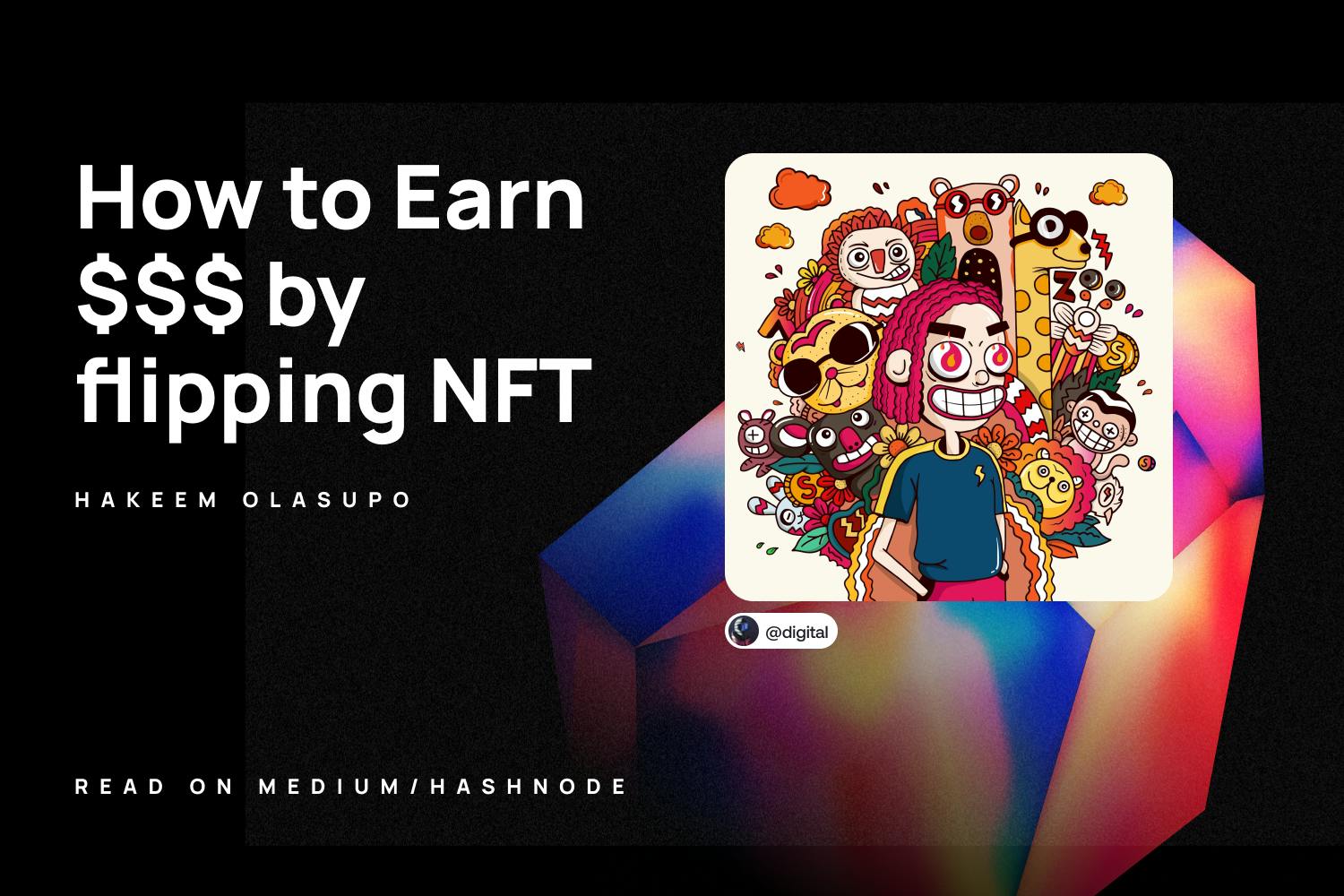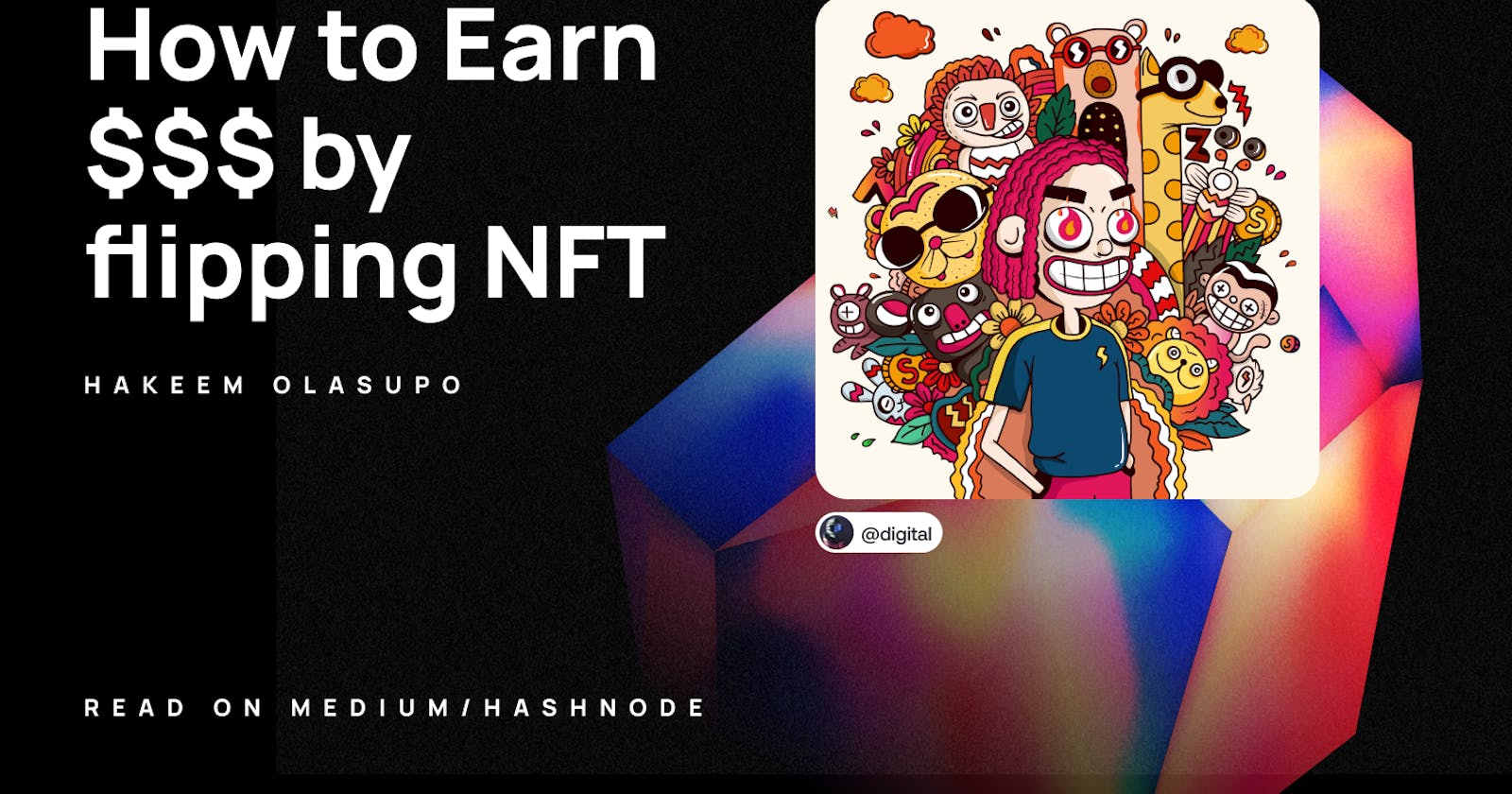Table of contents
No headings in the article.
First things first, I would want you to read more about NFT, I shared an article that explained what that's all about here medium.com/@Digital4us/relationship-between..

What is Flipping?
Flipping in a simple way is much like a term for buying NFT items at lower prices and selling quickly for a profit at higher prices.
However, before we get too deep, I am not giving financial advice, and any actions you take are done at your own risk. Hopefully, you can flip NFTs and make some money. But, of course, there is an inherent risk like any venture/investing.
When you flip an NFT, aside from you making money, a portion of the profit goes back to the creator(s) of the item. As a flipper, you also help spotlight collections, which drives up demand, creates a push on supply and leads to automatic royalties.
However, flipping is not a foolproof way to make money. Some crowds generate fraudulent "pumps" and hype to boost value and volume. These people then trade the NFTs and cash out immediately. Lamentably, novices are often too late to buy before the dump, losing funds. These things can be deadly since they can eliminate enormous sums of cash in minutes.
How to Find a Perfect NFT Project To Invest In
Finding the art you want to invest in is the hardest part; there are so many choices! There are many, many factors, and here are three things you can use as your guide.
As with any financial market, making profits requires analyzing metrics to make the best possible decision. Generally, people always go for assets that are currently undervalued or they expect to increase in value.
With NFTs, you need to find your niche and do quality research. Common niches include animal-themed art, abstract paintings, collectibles, domain names, or even virtual pieces of land.
Among other factors, three key metrics primarily determine how well an NFT project will do. These are: Background of the Artist: It's seemingly the most solid variable for recognizing a piece's long-term profit. When it comes to collections, research the founding team. What is their history in space? What is their reputation? What is their consistency over time? Sales volume? Collabs?
- Number of Items: scarcity always drives demand up. NFT projects with a limited quantity of items are much more likely to give you a profit.
- Floor Price: Floor price means the least price you can get an item. It's the base cost, e.g., the least expensive piece in a collection, which tells a potential buyer how much they need to spend to get in the door. A floor is additionally a comprehensive approach to understanding the existing trend (down or up). However, a downside to a floor is other buyers can alter it via buying binges; that said, you can still use it to gauge the trend if the floor is volatile or if it's steadily moving one way or another. Both have pros and cons, just like any other form of "investing," as you can see exponential gains/losses or more organic movement.
- Volume: Making profits in any market is firmly hinged on liquidity. You want to pitch your investments with platforms with high trading volumes. Chances are you will quickly see collectors willing to buy your items. Low volume indicates a price reduction, but high volume indicates liquidity, and liquidity is the boss.
*Here's what I mean.
The capacity to market fast anytime you want is a significant cause why 50,000 piece collections perform great since 25,000 people are waiting to purchase your NFT.
Getting Started
Flipping NFTs follows a simple process. You need a Web3 compatible wallet like Metamask or Trust Wallet. After funding your account, you can access various NFT platforms using the in-app browser. If you understand those ideas, go ahead and flip NFTs. Word to the wise, though, don't make decisions based on emotions, FOMO, or any FUD (fear, uncertainty, or doubt).
You can get started with the AirNFT, OpenSea, Foundations websites.
And always have it in mind, you can only make a profit as long as you see buyers willing to buy. Hence, you must take care to invest what you can afford to lose.
Furthermore, consider gas fees (typically about 2.5 percent) and artists' royalties (anywhere from 1 percent to 30 percent) when establishing the selling price.
Discover Your Niche Some of the best advice I've heard about NFTs is to research the stuff you genuinely believe will succeed; this means you pick your niche of NFTs, then study it. The more information you get about a particular NFT scene, the more profitable your investment findings will end up being. So it's crucial to select a couple (or even just one) of NFT niches and dive into those communities.
*Some great ways to quickly get into a niche's communities:
- Subreddits and forums
- Podcasts
- YouTube Channels
- Discuss and talk to other people in that community
This measure requires time and effort but is the ideal way to make suitable investments.
Lastly, have fun!
All in all, this article tells us that there are plenty of opportunities for everyone who is willing to dedicate time and effort to anything, be it flipping non-fungible tokens.
Of course, none of the above should be construed as financial advice. Trading NFTs, just like trading everything else, carries a serious risk of capital loss, and you should never risk more than you can afford to lose.
**I would appreciate some love on this post! So comment, like/clap, and give me a follow on here!
Also, let me know if you need crypto and NFT content written for your blog (such as Hashnode, or any other platform!), website, or ebook! I've been a professional writer for over 2 years.**
Contact Me
If you’ve got any questions or feedback, I’d love to hear from you. I am also eager to hear your burning questions about #flipping #crypto, #web3, #nft, #design, #metaverse, leadership, career — and personal development! Drop me a line at aolasupo99@gmail.com for media inquiries.

